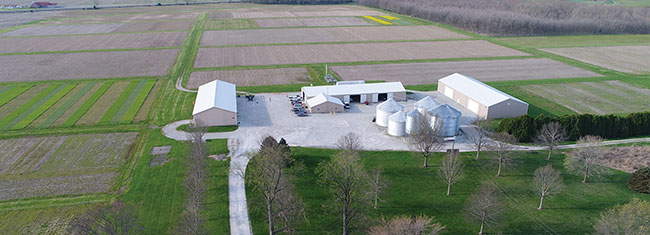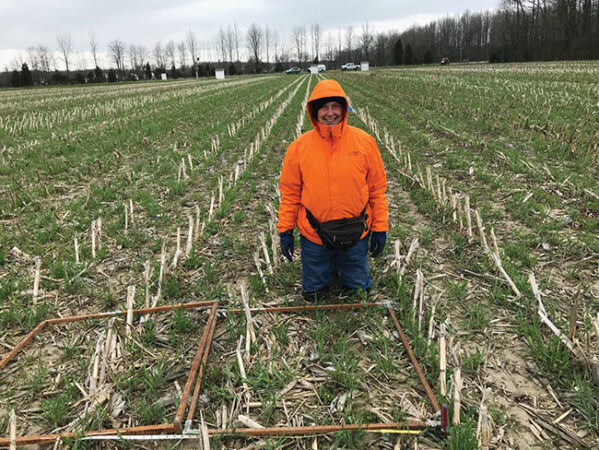
Features
Drainage Management Systems
Environment
Top stories of 2023: Drainage pays (seriously)
A 35-year Indiana study proves drainage improves yields, and conservation efforts, in poorly drained soil
December 18, 2023 By Julienne Isaacs
 The Southeast Purdie Agricultural Research Center (SEPAC) was the site of a three-decade-long subsurface drainage project.
All images courtesy of Purdue University/Eileen Kladivko
The Southeast Purdie Agricultural Research Center (SEPAC) was the site of a three-decade-long subsurface drainage project.
All images courtesy of Purdue University/Eileen Kladivko When Eileen Kladivko joined Purdue University’s agronomy department as an assistant professor more than 40 years ago, her new colleagues were just beginning a new drainage research study at the Southeast Purdue Agricultural Center in Butlerville, Indiana that aimed to assess the effects of tile drainage on crop yield, soil physical properties and erosion.
“The original thought was that this would probably be a 10 year experiment,” says Kladivko, now a full professor at Purdue. But the study, which began in 1983, ran for 35 years before it officially wrapped up in 2017. (In its most pared-back form, the study is still ongoing at the Butlerville site: yield data is still being collected).
Along the way, says Kladivko, it gained new research questions, including an experiment focused on nitrate leaching and a large conservation practices experiment. “Originally, there was no goal related to water quality or cover crops. We had several major goals, and different sub-goals got added,” she says.
Taken together, the results from the Butlerville study’s 35 years of experiments offer a treasure store of information on the value of drainage systems for poorly-drained soils. Kladivko’s findings have been published as extension articles on Purdue’s website and in scholarly journals. More publications are pending as Kladivko and her colleagues continue to parse the data.
“I think we’ve pretty much answered the questions we originally set out to answer,” says Kladivko. These answers have relevance for farmers in southeastern Indiana, but will be useful for farmers and contractors across the country working with naturally poorly-drained soils.
Yield results
In the northern part of Indiana, most soils have been tile-drained for decades. In Jennings County in southeastern Indiana where one of Purdue’s experiment stations is located, the Clermont silt loam soils are very wet and require drainage, but before the study began, “the old clay tiles didn’t work,” says Kladivko.
“That soil [had] very high silt, low clay, low organic matter. It had almost no internal structure. When it was wet it would slump, the silt seeped into the cracks between the tiles and eventually silted up the tile with sediment,” she says. Farmers in the area were forced to do surface drainage by grading the fields with land levelling equipment to allow them to drain down the slope into shallow ditches.
“They were able to drain the fields by using surface shaping and drainage, but that required a lot of maintenance because they would deteriorate with time. That was the time before no-till, so they’d have to remake those every year,” she says. “When plastic tiles started coming out in the 1970s, folks in that part of the state were petitioning Purdue to do some work on modern perforated plastic drain tube to see if that would work on their soil.”
The experiment was set up with three drain spacings – 16, 33 and 66 feet – and an “undrained” control at a spacing of 133 feet.
Kladivko and her colleagues used four-inch-diameter perforated-plastic lateral drain tubes without socks or filters, installed at a 0.4 percent grade at a depth of 2.5 to three feet, or above the fragipan, which was generally about 3.5 to four feet deep.
In the first 10 years of the experiment, all of the four drain spacing treatments were tilled and planted to corn and soybeans based on when soil was considered ready for tillage.
Depending on how wet or dry it was in each year of the study, drainage improved the timeliness of fieldwork by one to 15 days.
Larger yield difference occurred later in the study, when weather was generally wetter. Average corn yields over the entire study period were 168, 163, 162 and 144 bu/ac for the 16-foot, 33-foot, 66-foot and 133-foot plots, respectively, says Kladivko.
By contrast, the researchers did not observe differences in soybean yields in the four treatments; yields averaged 57 bu/ac. Kladivko speculates that this is due to the fact that soybeans are planted later, after the wettest period is past.

Kladivko says drainage tends to improve the timeliness of fieldwork by one to 15 days.
Conservation experiments
Another major component of the 35-year trial was its focus on interactions, or “synergies,” between tile drainage and conservation practices such as zero tillage and cover cropping. The researchers wanted to assess whether tile drainage improved soil physical properties and cover crop growth.
This agronomic treatment experiment, added in 1985 and conducted for nine years, had two blocks: one with tile drainage at 50-foot spacing, and one with no tile drains.
The looked at five treatments, split between tillage and zero tillage, replicated four times in each subfield: continuous corn, corn with a wheat or cereal rye cover crop, corn with an annual ryegrass cover crop, corn with dry manure, and a three-year rotation with corn-wheat-orchardgrass or corn-wheat-red clover.
For the continuous corn treatment, the tiled block saw 12 percent higher yields versus the untiled control. The conservation treatments with wheat or cereal rye cover crops, ryegrass cover crops or dry manure saw yield improvements of about 20 percent over the control.
“I’ve got a picture of cover crop growth in the drained versus the undrained control,” says Kladivko. “The drained [block] had about four times the biomass [than the undrained block] in that particular year. Almost always, there was less growth where soils were undrained, compared to where soils were drained.
“The implication that I got from that is that if you’re going to have conservation practices, you need to take care of drainage first,” she says.
Applications
When it comes to how drainage can improve conservation practices, there’s a crucial point to underscore, says Kladivko.
Some soils, like the post-glacial Clermont silt loam in southeastern Indiana, have a very high water table at certain points of the year that’s unaffected by farmers’ practices “at the top.”
“Naturally poorly drained areas may have cemented areas that hold water up. With a dense glacial till, the top two to three feet [can be] good soil, then there’s a layer at some point that’s much denser, at three to four feet deep, so at certain times of the year, the water goes into the soil, and can only move down into that layer very slowly.”
Soils with a natural high water table present different challenges than compacted soils. The use of cover crops can go a long way to correct compacted layers in the latter case, says Kladivko. But in naturally poorly drained soils like those in southeastern Indiana, water tends to pond at three feet below the soil surface. Cover crops planted in soils like these will struggle to produce much biomass.
“The shallow water table of naturally-poorly-drained soils is the first limitation to growth of cover crops or cash crops,” writes Kladivko in a summary on the research. “It must be managed in order to provide adequate aeration for crop roots and soil biology, and their subsequent improvement of soil health.”
Kladivko says the results speak for themselves: for farmers in Jennings County, drain tile is a good investment.
That isn’t to say the study’s narrowest spacing design should be implemented by farmers. Although the 16-foot spacing saw the highest yields, Kladivko says it also saw higher nitrate leaching into the drains than the other spacings. During the first three years of the trial (1985-1988), nitrogen losses were 24, 32, and 44 lbs N/acre for the 66-foot, 33-foot and 16-foot spacings, respectively. When cover crops were planted, nitrate concentrations and loads were reduced in the tiled blocks. Leaching issues aside, depending on soil types, the narrowest drain spacing likely isn’t economical for most farmers. As always, farmers need to take their own soil conditions into account when developing drainage plans.
This summer, Kladivko hopes to publish an economic analysis of the study’s findings to help inform producers’ decision-making. Summaries of the 35-year study’s research data can be downloaded free on the Purdue Education Store at edustore.purdue.edu. DC
Print this page